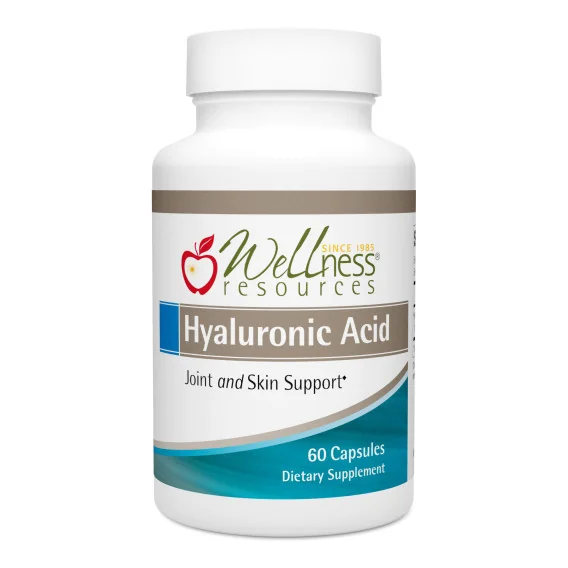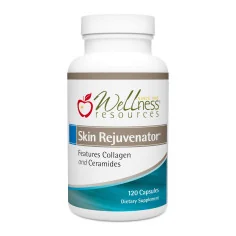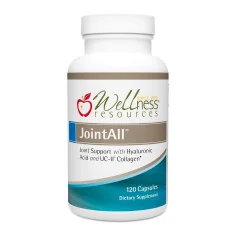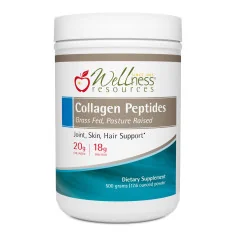Hyaluronic Acid Is Essential Nutrient for Body Structure
Hyaluronic Acid (HA) may very well be the single most important compound in the structure of the human body.* It makes up the backbone of cartilage, the synovial fluid around joints and under the skin, and even cushioning behind eyes. Wellness Resources Hyaluronic Acid is natural, low molecular weight hyaluronic acid. It is easily absorbed and used by the body, unlike cheap sodium hyaluronate.*
Wellness Resources uses the only form of hyaluronic acid (low molecular weight) that has been proven to be absorbed.* The hyaluronic acid in this supplement is extracted from rooster comb (a naturally occurring source), purified and enzymatically split into smaller pieces through a patented process. This yields the only low molecular weight hyaluronic acid on the market today.*
WARNING: sodium hyaluronate, being marketed as an inexpensive hyaluronic acid, is not the naturally occurring compound made by all cells of the body. It has salt attached to every single disaccharide unit. Not only does this increase sodium intake, the hyaluronic acid molecule itself is abnormal. This synthetic hyaluronic acid is typically made through bacterial fermentation, contains molecules too large to absorb, and has not been proven to absorb. This abnormal molecule cannot be relied on to behave in metabolism correctly.
Hyaluronic Acid and Basic Body Structure
Hyaluronic Acid is a key component of the extra cellular matrix. This matrix is made of a framework of various protein structures (collagen and proteoglycans). The spaces within this framework are filled with hyaluronic acid. The structure of hyaluronic acid enables it to hold water in tissues, forming a "goo" that provides cushioning, resiliency, and moisture.*
Synovial Fluid and Joints: Hyaluronic acid is a primary component of the synovial fluid that surrounds the joints. Synovial fluid is the lubrication for joints, much like oil is used to lubricate moving parts in a machine. It also directly feeds nutrition to joint cartilage. hyaluronic acid helps joints have resiliency, ease of movement, and cushioning to distribute mechanical loads (shock absorbers).*
Cartilage: Hyaluronic acid makes up the backbone structure of hyaline cartilage. Without the adequate hyaluronic acid backbone, cartilage will more readily fall apart and deteriorate. Hyaluronic acid makes up the backbone structure of cartilage. Without the adequate hyaluronic acid backbone, cartilage will more readily fall apart and deteriorate. Over the past ten years we have seen many individuals significantly improve joint health, including those with knee, hip, or low back problems.*
Skin: Hyaluronic Acid is a primary component of healthy skin. About 50% of the structural hyaluronic acid in the body is contained in the skin matrix. Declining skin levels of hyaluronic acid are associated with dryness, reduced flexibility, and wrinkles. In a study conducted at Ostuma University in Japan, 96 women, ages 22 to 65 years, were given the equivalent of 3.75 capsules of Wellness Resources® Hyaluronic Acid per day for 45 days. At the end of the study 80 women reported improvement in skin moisture and smoothness. hyaluronic acid has also been shown to help improve acne scars and sun damage.*
Eyes: Hyaluronic Acid makes up the fluid cushioning behind the eyes. hyaluronic acid is concentrated in the eye to help protect the eye against impact, acting like a shock absorber. hyaluronic acid may also help to reduce dry eyes.*
All Body Structure: Hyaluronic acid is one type of glycosaminoglycan (GAG), unique in that it is all carbohydrate and no sulfur. In addition to its goo-like properties, hyaluronic acid forms the "spine" or backbone of other GAGs.* Other GAGs contain sulfur, also important for body structures. Common GAGs are: chondroitin sulfate (cartilage), keratin sulfate (cartilage, bone, and cornea), dermatan sulfate (skin, tendons, lungs, blood vessels, heart valves), and heparin sulfate (cell membranes).
GAGs combine to form larger molecules called proteoglycans, which link to other proteins and collagen to form all body structures. Although hyaluronic acid is not the most dominant compound in these structures, it is the one that is vital to the structure existing.*
Hyaluronic Acid Improves Sleep
Hyaluronic Acid assists in the natural repair process that takes place during sleep. Take 2 before bed to enhance joint and skin repair during sleep. Hyaluronic Acid is also known to help you sleep better and wake up feeling more refreshed.*
How Your Body Makes Hyaluronic Acid
Cells throughout the human body produce hyaluronic acid. The million dollar question is: Are they making enough? The starting nutrients your body uses are two sugars, D-Glucuronic acid and N-Acetyl Glucosamine. D-Glucuronic acid occurs widely in the plant kingdom and is a component of cellulose and soluble fiber gums (like Nutrim® oat fiber in Fiber Helper).
N-Acetyl Glucosamine (NAG) is a different nutrient than the glucosamine sulfate or glucosamine hydrochloride found in most joint support supplements. It is made by combining the amino acid glutamine to glucose. A primary location of NAG synthesis is by the endothelial cells lining the GI tract, a process that may not work so well if there is digestive distress.* Our GI & Muscle Helper™ supplement is a combination of glutamine and already formed N-Acetyl-Glucosamine, nutrients that readily support hyaluronic acid formation.*
The stimulus for cells to make hyaluronic acid can come from a variety of metabolic signals, responding to the common theme for increased body need for structural support. Thus, exercise is one way to help stimulate hyaluronic acid production. Cells throughout the body make hyaluronic acid as part of the natural repair and recovery process.*
Cells use an enzyme called hyaluronic acid synthase to assemble the hyaluronic acid molecule. This enzyme requires magnesium and energy (ATP) to work properly.* Hyaluronic acid synthase is inhibited by stress hormones.*
Hyaluronic Acid, The New Frontier
While hyaluronic acid was discovered in 1934, until 10 years ago the hyaluronic acid molecule was thought to be passive and simply a structural component (like a 2 x 4 in a wall). Despite its simple structure, dramatic scientific research is now showing that hyaluronic acid is one of the most biologically active compounds in the human body.* These functional characteristics of hyaluronic acid are causing scientists to change its nickname from a space filling "goo" to "magic glue."*
Hyaluronic acid is now believed to play a functional role in the formation of new body tissue, providing the organizing matrix around which new connective tissue is built.* In essence, hyaluronic acid acts as a template to assist in the formation of body structure.* A single molecule of hyaluronic acid, which may be quite long, can attach to hundreds of other structural protein molecules, assisting in the formation of body structure.*
Natural Supplement to Maintain Structure
The new science is showing that hyaluronic acid may operate as the brains of this operation, helping to regulate how the body grows, stabilizes, and maintains structure.* An elaborate and complex array of hyaluronic acid enzymes, cell surface receptors, and binding proteins are being identified.* Much of this new research is focusing on the role of hyaluronic acid in endothelial cells that line arteries, seeking to identify how hyaluronic acid assists in the maintenance of the health of the circulatory system.*
Hyaluronic acid is also being extensively studied in relationship to cartilage and bone formation and natural regeneration processes.* The specific sequence by which hyaluronic acid guides these processes is now being identified, placing Hyaluroic Acid and JointAll as our top joint support supplements.*
This does not mean that hyaluronic acid replaces other structural support nutrients such as dietary protein, glucosamine, chondroitin, MSM sulfur, vitamin C, or bioflavonoids. Indeed, hyaluronic acid is a relatively small amount of the final structural material of any body tissue. Other structural nutrients are very important as they are attached to hyaluronic acid to produce the finished product.* However, hyaluronic acid has special importance amongst all structural support nutrients.* Hyaluronic acid is not only required as a fundamental structural nutrient, it is intimately involved with managing the building and remodeling processes.* It appears to be a guiding force behind organizing body structure.*
One molecule of hyaluronic acid may have as many as 10,000 disaccharide units. The weight of this long chain is measured in Daltons, weighing in between 1 to 1.5 million Daltons. This large molecule of hyaluronic acid cannot be absorbed by the human digestive tract as it is simply too long to enter endothelial cells lining the digestive tract.*
Wellness Resources uses the only form of hyaluronic acid (low molecular weight) that has been proven to be absorbed.* The hyaluronic acid in this supplement is extracted from rooster comb (a naturally occurring source), purified and enzymatically split into smaller pieces through a patented process.














